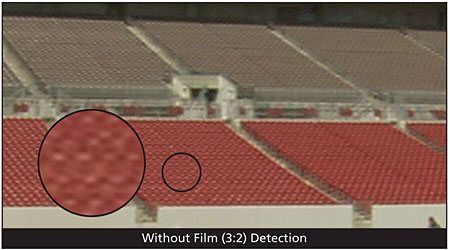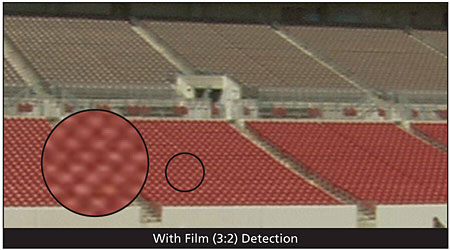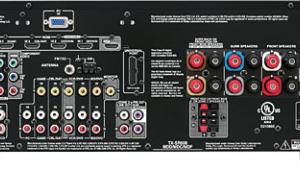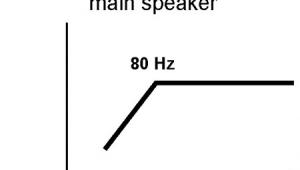1080p/24
In our November 2006 issue, I wrote an article in this space on the difference between 1080p and 1080i. In the same issue, we reported on how many TVs don't deinterlace 1080i correctly, and how even fewer pick up the 3:2 sequence when given a 1080i signal from a film-based source. The resulting confusion caused a torrent of e-mails. Let me clear up what this all means for you. But, before I go on, let me make one thing perfectly clear: I feel that every TV should deinterlace and pick up 3:2 properly; but, while it is a shame if they don't, it is not the end of the world.
What's the Deal?
The short version of the November article is this: Most HD sources are based on 24-frame-per-second material (either from film or 24-fps HD cameras). Sports aren't 24 fps, but movies and nearly all non-reality-TV shows are. To display something that has 24 frames in a second on something that refreshes 60 times per second (nearly every TV), you need to create new frames. This is done by a process called 3:2 pulldown (more accurately, 2:3 pulldown). This process doubles the first film frame, triples the second, doubles the thrid, and so on. So, while the original film would be A, B, C, D, the version after 3:2 pulldown would be A, A, B, B, B, C, C, D, D, D, etc.


The difficulty is that every digital display is progressive, and not every source is 1080p. When you send interlaced material (either 1080i or 480i) to a progressive display (1080p or 720p), the display needs to take the individual fields (half a frame) and combine every two into one frame to show on the screen. With video-based material, the processor combines each field with the next field in the sequence (hopefully). Better processors can sense a difference between the fields (say, any fast motion) and create a sort of combination between the two fields. Technically, some resolution is lost, but the converse would be artifacts. That's hard enough to do, but the real trick is film.
The first step is for the processor to figure out that the incoming signal is based on film. To do this, it needs to hold several complete frames in its memory. Each frame is essentially a 2-megapixel picture, so this takes a lot of memory—that is to say, a lot of memory for a TV, anyway. The reason it needs to know this is because, if you just mash film-based fields together, every few frames, there are ones that are made up from half of one film frame and half of another (see bottom diagram). So, the sequence becomes A, A, B, B, BC, BC, CD, CD, D, D. As you see, the processor joins certain frames with completely different frames. This results in artifacts. In the past, with 480i to 480p, these artifacts were plainly visible as combing. The edges of moving objects would appear like someone had dragged a comb across them.
HD
Until recently, no one had material or equipment to test 1080i with 3:2 sequencing accurately. We could synthetically test whether a TV deinterlaced properly or picked up the 3:2 sequence, but what did it look like if it was wrong? Silicon Optix's HQV Benchmark HD DVD (and soon their Blu-ray) disc added a real-world example to test processors. Depending on its mode, Sharp's excellent XV-Z20000 projector can pass this test or not. So, on the same piece of gear, with real-world material, we can see what happens when a display does and doesn't pick up the 3:2 sequence with 1080i material.
The demo is a slow pan of a stadium. Processed correctly, this stadium looks like it should. The seats look like seats. Processed incorrectly, though, the rows of seats near the top of the stadium start to moiré—that is, they have lines in them that shouldn't be there that move separately from the seats. On the lower seats, there is a subtle motion artifact that looks like each seat is trying to vibrate slightly or that each seat has its own moiré pattern. The problems are extremely subtle and not nearly the eyesore of the combing problems with 480i. On a smaller TV (less than 50 inches or so), you probably won't notice anything unless you're sitting extremely close.

Film frames (top) in an interlaces 3:2 sequence (bottom).
1080p/24 Output
So, is the solution a 1080p/24 output from an HD DVD or Blu-ray player? Well, yes and no. It does minimize the processing, but the question is, rather, where is the best processing? If your player does a better job creating the 3:2 sequence than your TV, you'll get a better picture with a 1080p/60 output from the player. If your TV can change its refresh rate to a multiple of 24 (like some Pioneer plasmas' 72 hertz or some Sony and JVC projectors' 96 Hz), then it should be able to extract the 24 out of the 1080p/60 and display accordingly without any loss in resolution or adding artifacts. (Should is the key word.) If, for some reason, that freaks you out, then some Blu-ray players will output 1080p/24 directly. This is a cool (and seemingly obvious) feature but is by no means a major issue.
3:3, 4:4, 5:5
A better request of the TV manufacturers is to make TVs with adjustable refresh rates (like those mentioned above). The 3:2 sequence is inherently juttery. This isn't noticeable most of the time, but slow horizontal pans have a noticeable jutter (the image is jerky, not smooth). If your TV refreshes at 72, 96, or 120 Hz and correctly processes the 24-fps material, this can reduce the jutter. You can't truly eliminate the jutter (as film itself isn't as smooth as video, which has a higher frame rate), but you can certainly make it smoother. Please note that, although there are numerous 120-Hz LCD panels coming out, none do 5:5 pulldown (24 times 5). This is really unfortunate, as 120 is a magic number that is evenly divisible by both 60 (video) and 24 (film).

What incorrect deinterlacing can look like.
What Does It All Mean?
Correctly deinterlacing 1080i and identifying the 3:2 sequence are important tasks that all TVs should do. That said, it is still just one aspect of performance. Take two imaginary displays; one has an excellent contrast ratio, black level, and color but doesn't pick up the 3:2 sequence, and the other picks up the 3:2 but has a poor contrast ratio, black level, and color. Without question, pick the one that has the better contrast ratio, black level, and color. These performance aspects are far more noticeable than incorrect processing. Additionally, and if the TV can accept 1080p, you can always get a good scaler down the road (which hopefully picks up the 3:2 itself).














































